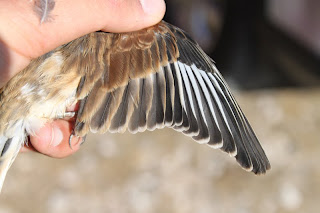At Fluke Hall Lane the pinkfeet were already flighting in to the cut barley field but very skittish and unsettled. I left them alone to take a look at the marsh from Lane Ends where I could better judge how many there were before they scattered far and wide. Looking left from the car park I counted 2000, maybe 2500 packed tightly on the green marsh where Pilling Water joined the sea. Two Barnacle Geese hid amongst the crowd of pinkies.


Further out to the left but quite close to the geese were the eight white beacons of Whooper Swans, just moving around a little, but even as I watched from that distance I heard their familiar deep trumpeting. Not today's birds below.

Overhead a single crow harassed a little Sparrowhawk as it flew to the east and over the plantation before disappearing from view. I heard a couple of Meadow Pipits and Skylarks come over but I really wanted to get to Conder Green early, which after a wander around, would still allow me time to return and “do” the incoming tide at Lane Ends.
Quiet at Conder, but I rarely see anyone there early morning. I thought birders got up early? Maybe they were all exhausted after the Leach’s day or maybe they had all gone to look for them today?
I could almost have filled in my notebook before I got there, at least for the regulars: 75+ Teal, 2 Spotted Redshank, Greenshank, 7 Snipe in the creek and a Common Sandpiper. For variation I found a single Bar-tailed Godwit, and then walked the cycle path for a while, where a party of about 40 Goldfinch flitted about the hedge tops and the usual tit party roved up and down. There were definitely a few extra vocal Reed Buntings this morning, with a couple near the pool screen and another three together along the cycle path. I took a not very good picture of one as it sat on the hawthorn tops.

Noticeable this morning was a flock of about 30 Skylarks disturbed from the marsh just north of the path, as they rose as one then gradually dropped back into the grasses to remain unseen. I had a couple of Swallows here, quite high and going south east.
A quick look at Braides still very dry, gave me upwards of 200 Lapwing, probably 20 Golden Plover and 30 Curlew in the closest fields. Curlews always amuse me by the way they start to walk away from a moving car if it so much as slows down; they obviously associate us humans and/or vehicles with something unpleasant.
My timing for the midday tide at Lane Ends was good and I walked to Pilling Water, taking up my usual spot at 1015, plenty of time. The bonxie was pretty much the first bird but it wasn’t obviously a bonxie, just a large black blob sitting on the sand in the distance, half way to Heysham. A bit of “is, or isn’t it” followed until the creature moved, even flexed its wings to reveal the flashes. The local Peregrine, usually top dog of the tide line took a dislike to the skua, dive bombing it a couple of times before flying off itself towards Fluke and over the sea wall. A couple of Carrion Crows didn’t rate the intruder either as they stood next to it, one even trying to nip the bonxie’s tail end. Eventually the bonxie flew out to sit on the incoming tide for a while, then after some minutes flew in a determined manner towards the tide line where it scattered wildfowl, waders and even geese before flying east towards Bank End. Such excitement, but it’s not everyday we see a bonxie, especially at Lane Ends so far into the bay.

At least the lull gave chance to look around, time to see a bright but pale northern type Wheatear amongst the stones and a few Linnets and grounded Meadow Pipits. Three Little Egrets today.

Duck numbers were much as last week with several hundred of both Teal, Pintail and Wigeon but really the tide was again a little low to push the birds closer for a proper count.
Wader numbers were similarly low with single digits of Dunlin, Golden Plover and Snipe but a few more Redshank today, probably 120 +.
A nice morning out, again.





























.jpeg)












.jpg)












